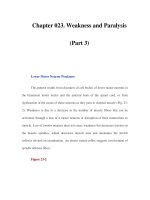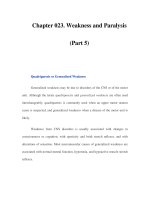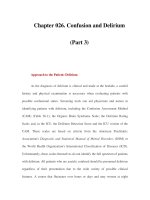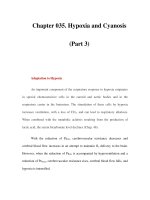Chapter 058. Anemia and Polycythemia (Part 12) ppt
Bạn đang xem bản rút gọn của tài liệu. Xem và tải ngay bản đầy đủ của tài liệu tại đây (51.78 KB, 5 trang )
Chapter 058. Anemia and
Polycythemia
(Part 12)
Approach to the Patient: Polycythemia
As shown in Fig. 58-18, the first step is to document the presence of an
increased red cell mass using the principle of isotope dilution by administering
51
Cr-labeled autologous red blood cells to the patient and sampling blood
radioactivity over a 2-h period.
If the red cell mass is normal (<36 mL/kg in men, <32 mL/kg in women),
the patient has spurious polycythemia. If the red cell mass is increased (>36 mL/kg
in men, >32 mL/kg in women), serum EPO levels should be measured.
If EPO levels are low or unmeasurable, the patient most likely has
polycythemia vera. Ancillary tests that support this diagnosis include elevated
white blood cell count, increased absolute basophil count, and thrombocytosis.
A mutation in JAK-2 (Val617Phe), a key member of the cytokine
intracellular signaling pathway, can be found in 70–95% of patients with
polycythemia vera.
Figure 58-18
An approach to diagnosing patients with polycythemia.
RBC, red blood cell; EPO, erythropoietin; COPD, chronic obstructive
pulmonary disease; AV, atrioventricular; IVP, intravenous pyelogram; hct,
hematocrit.
If serum EPO levels are elevated, one attempts to distinguish whether the
elevation is a physiologic response to hypoxia or is related to autonomous
production.
Patients with low arterial O
2
saturation (<92%) should be further evaluated
for the presence of heart or lung disease, if they are not living at high altitude.
Patients with normal O
2
saturation who are smokers may have elevated EPO levels
because of CO displacement of O
2
. If carboxyhemoglobin (COHb) levels are high,
the diagnosis is smoker's polycythemia. Such patients should be urged to stop
smoking.
Those who cannot stop smoking require phlebotomy to control their
polycythemia. Patients with normal O
2
saturation who do not smoke either have an
abnormal hemoglobin that does not deliver O
2
to the tissues (evaluated by finding
elevated O
2
-hemoglobin affinity) or have a source of EPO production that is not
responding to the normal feedback inhibition.
Further workup is dictated by the differential diagnosis of EPO-producing
neoplasms. Hepatoma, uterine leiomyoma, and renal cancer or cysts are all
detectable with abdominopelvic CT scans.
Cerebellar hemangiomas may produce EPO, but they nearly always present
with localizing neurologic signs and symptoms rather than polycythemia-related
symptoms.
Acknowledgment
Dr. Robert S. Hillman wrote this chapter in the 14th edition, and elements
of his chapter were retained here.
Further Readings
Hillman RS et al: Hematology in Clinical Practice, 4th ed. New York,
McGraw-Hill, 2005









